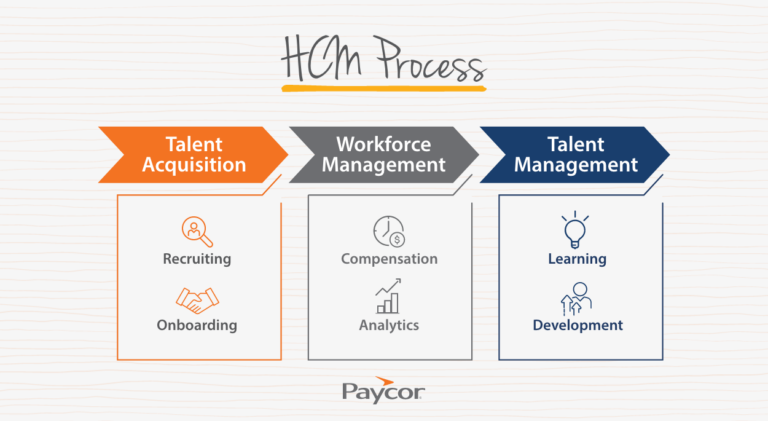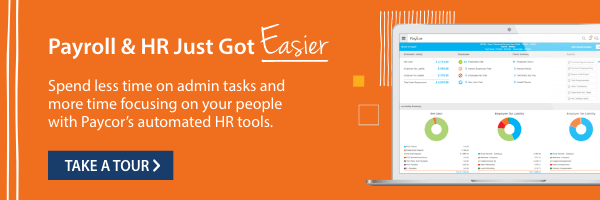In any organization, the people are the strongest asset. As such, businesses must be strategic with their most valuable resource, treating the workforce as a value driver rather than a cost center. Through human capital management (HCM), companies can ensure they:
- Hire the best talent
- Onboard effectively
- Promote employee growth
- Improve productivity
- Retain employees
Read on to learn more about what HCM is in a business context, why it matters, and how HCM software simplifies and optimizes people management.
What is Human Capital Management?
HCM refers to the set of practices an organization uses to acquire, train, manage, develop, and retain employees. HCM focuses on maximizing each step of the employee lifecycle, turning traditional HR tasks into opportunities to improve operations.
According to Schroders’ research, in partnership with Saïd Business School, the University of Oxford, and the California Public Employees’ Retirement System, effective human capital management can lead to improved outcomes.
What Are the Key Components of HCM?
HCM involves the entire employee lifecycle, from workforce acquisition to performance management. Every standard HR practice, such as payroll, scheduling, and benefits administration, is a part of HCM and presents an opportunity to invest in employees and your company.
Key HCM components include:

- Talent acquisition: Recruiting the right candidates and streamlining the hiring process.
- Onboarding: Ensuring smooth integration of new hires with tools for training and engagement.
- Performance management: Monitoring and evaluating employee performance to drive productivity.
- Learning and development: Offering continuous development opportunities to foster growth and skill-building.
- Compensation and benefits: Managing payroll, benefits, and rewards to retain employees and maintain satisfaction.
- Workforce planning: Using analytics to forecast workforce needs and optimize team makeup.
What Is HCM Software?
The main vehicle for human capital management that transforms HR functions into strategic advantages is an HCM platform. HCM technology integrates and automates all HR processes into a single platform, eliminating the time spent logging into various point solutions that create data silos.
From recruiting and onboarding to payroll, performance management, and employee development, HCM software streamlines the entire employee lifecycle. An all-in-one HCM platform enables HR teams to manage people-related tasks more efficiently, reducing manual workload and administrative errors.
According to HG Insights, nearly 2 million companies in the United States spend $13.3 billion on HCM software, and this is only expanding. The market report, released in May 2024, predicts 362,000 companies will spend $34.3 billion globally on HCM solutions in the next 12 months.
With the rise of remote and hybrid work creating distributed teams, the need for improved compliance management for rapidly changing regulations, and a growing focus on employee development, HCM software is no longer a luxury but a necessity for businesses of all sizes. Its ability to centralize data, improve decision-making, and enhance employee experience makes it a must-have tool for organizations looking to stay competitive in today’s fast-paced business environment.
What Are the Benefits of HCM Software?
HCM software offers a wide array of benefits that help businesses streamline HR processes and elevate their workforce management strategies. Key advantages include:
- Efficiency and automation: HCM software automates repetitive administrative tasks, reducing manual errors and freeing up time for human resource professionals to focus on employee development and other strategic initiatives.
- Improved employee experience: With self-service capabilities, employees can easily manage their personal information, request time off, and enroll in benefits, leading to increased satisfaction and engagement.
- Enhanced talent management: HCM platforms centralize recruitment, onboarding, performance management, and employee development. This enables organizations to hire the right people and provide them with the tools to grow, improving retention and overall performance.
- Data-driven insights: HCM software collects and analyzes data in real-time, giving businesses the ability to make informed decisions about workforce planning, budgeting, and more.
- Scalability and adaptability: As businesses grow, HCM software scales with them, allowing companies to adapt quickly to changing workforce needs without overhauling their HR systems.
- Compliance management: HCM solutions help organizations stay compliant with evolving labor laws and regulations, minimizing the risk of non-compliance penalties.
Best Practices for Implementing HCM Software
Successfully implementing HCM software requires careful planning and execution to maximize its benefits. Implementation best practices include:
Define clear objectives:Before selecting an HCM platform, identify your organization’s key HR challenges and set clear goals for how the software will address them. Whether you aim to streamline recruitment, enhance compliance, or improve employee engagement, aligning the software’s capabilities with business objectives is critical.
Involve key stakeholders: Engage the HR and IT departments, as well as other department leaders, in the selection and implementation process. Their insights help ensure the software meets the needs of various teams.
Ensure data accuracy: Give yourself a fresh, error-free start by cleaning and validating employee data before transferring it to the HCM platform.
Prioritize training: Ensure all HR professionals and employees receive adequate training on how to use the new system. A well-informed team will adopt the software faster, leading to higher efficiency and user satisfaction.
Customize for your business: Many HCM platforms offer customizable options. Tailor the system to match your organization’s specific workflows and processes for a more seamless experience.
Monitor and evaluate: After implementation, continuously monitor system performance and collect feedback from users. Regularly review metrics such as employee engagement, operational efficiency, and compliance to assess the system’s effectiveness and make necessary adjustments.
How Paycor Helps
Paycor’s HCM software helps modernize people management for 30,000+ organizations. The unified platform streamlines and optimizes every aspect of the employee lifecycle, from talent acquisition and training to payroll and benefits administration.
Among its robust features are:
- HR + Payroll: Drive efficiencies with software that streamlines payroll, reduces tax compliance risk, and enables employees to self-service time off requests, contact information changes, and more.
- Talent Acquisition: Discover new candidates, quickly fill open positions, and provide engaging onboarding with software that leverages AI to automate sourcing and increase candidate diversity.
- Talent Management: Create an exceptional workplace where employees thrive, contribute, and succeed together with talent management solutions that include a learning management system, talent development, and compensation management for pay increases and bonuses.
- Workforce Management: Integrated time and advanced scheduling features enable companies to manage labor costs, automate scheduling tasks, minimize compliance risks, and ensure optimal coverage at all times.
- Benefits Administration: Build a comprehensive benefits plan that attracts and retains top talent while simultaneously simplifying benefits administration.
- Compliance Solutions: Reduce risk, save time, and simplify compliance management. Paycor’s compliance experts help customers stay ahead of changing regulations.
With Paycor, companies not only improve operational efficiency, but also foster a more engaged, productive, and satisfied workforce. Ready to see how an all-in-one HCM platform can benefit your business? Take a guided tour today.










